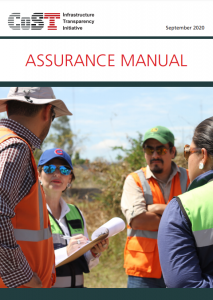Today CoST publishes its robust Assurance Manual and Guidance Note, to help further the work of our members and others to enhance CoST delivery and deepen our global impact. Assurance is the first of several important guidance products we will publish over the coming months which respond to lessons learnt from the CoST journey and a demand from members. Importantly, the package arrives as our newest members begin to step-up their programme implementation.
An assurance kick-off
Assurance – one of the four features of our approach – highlights issues in disclosed data which key stakeholders can use to demand better infrastructure. It means that fundamental issues harming the sector, such as a lack of competitive bidding or budget and time overruns can be clearly indicated and in turn rectified. Assurance translate complex messages into clear and compelling information both in written and visual form so an easy grasp of its insights is given.
– one of the four features of our approach – highlights issues in disclosed data which key stakeholders can use to demand better infrastructure. It means that fundamental issues harming the sector, such as a lack of competitive bidding or budget and time overruns can be clearly indicated and in turn rectified. Assurance translate complex messages into clear and compelling information both in written and visual form so an easy grasp of its insights is given.
The detailed Assurance Manual can help CoST members (and others) further the effectiveness of their assurance process. They will be more equipped to produce accompanying assurance reports which are compelling, substantiated and which generate impact. Through these reports a key tool is provided to strengthen trust and improve performance in the sector.
Key aspects of the Assurance Manual
Whilst providing a comprehensive overview, the Manual’s content can be adapted to each member’s local context. Newer members can take a deep dive into its sections, whilst more mature programmes can home in on certain areas. Important sections of developing an assurance report are outlined such as the need for a concise Executive Summary and clear Recommendations on actions.
More specific elements include:
The role of the Multi-Stakeholder Group

The Multi-Stakeholder Groups (MSG) of members comprise high-level actors from across government, private sector and civil society who help to guide programme delivery. As they are key to ensuring uptake of the report and defending its findings and recommendations, the Manual includes a whole section on their involvement. Key focus areas include important considerations to check on a report’s facts and ensure quality reporting. Their role in enabling a successful report launch is also emphasised.
Assisting the assurance team
An assurance team is appointed by members to carry out the process and draft the report. Their key activities are detailed to help them best prepare, undertake and follow up on assurance site visits. Helpfully, following guidance to create a compelling report, a template of the ‘core elements’ is provided and tips on overcoming common challenges such as being bogged down in detail and getting started on drafting.
Turning assurance into action
Assurance has little if any value if it does not contribute to impact. The report must be given due credit through a high-level launch event and other actions. Details are provided on who should be invited to speak and attend from across government, the private sector and civil society, as well as a template agenda and key elements to ensure findings are communicated effectively.
Finally, to make things simpler for members, useful tools, checklists and resources are also included within the Manual’s Annexes.
What’s next in line for our guidance package?
Stay tuned as we produce more guidance on our other three core features – multi-stakeholder working, disclosure and social accountability. Other important guidance will focus on how CoST can help to address pressing global concerns, such as promoting gender inclusion and the value and applicability of initiatives such as CoST in crisis.
